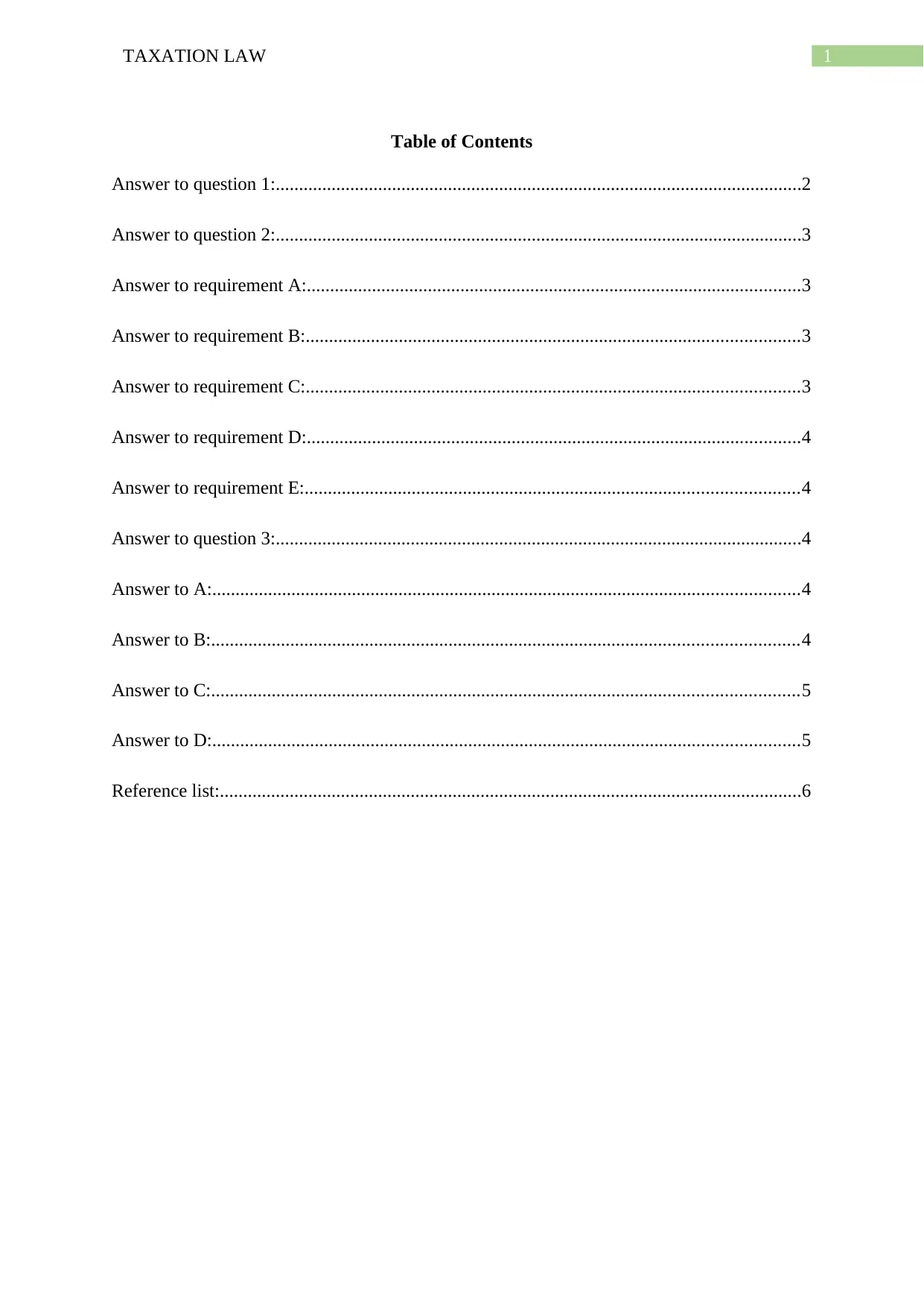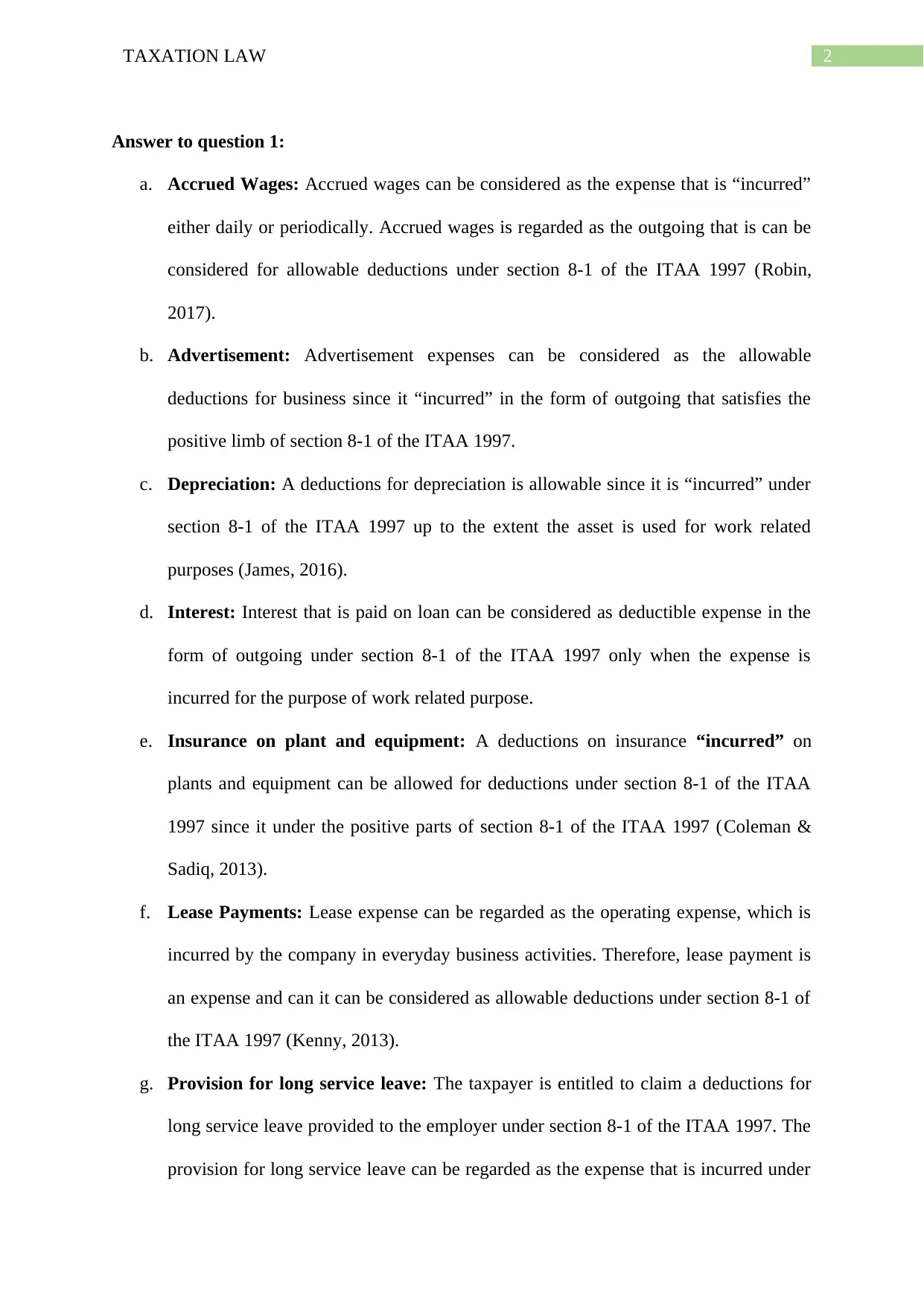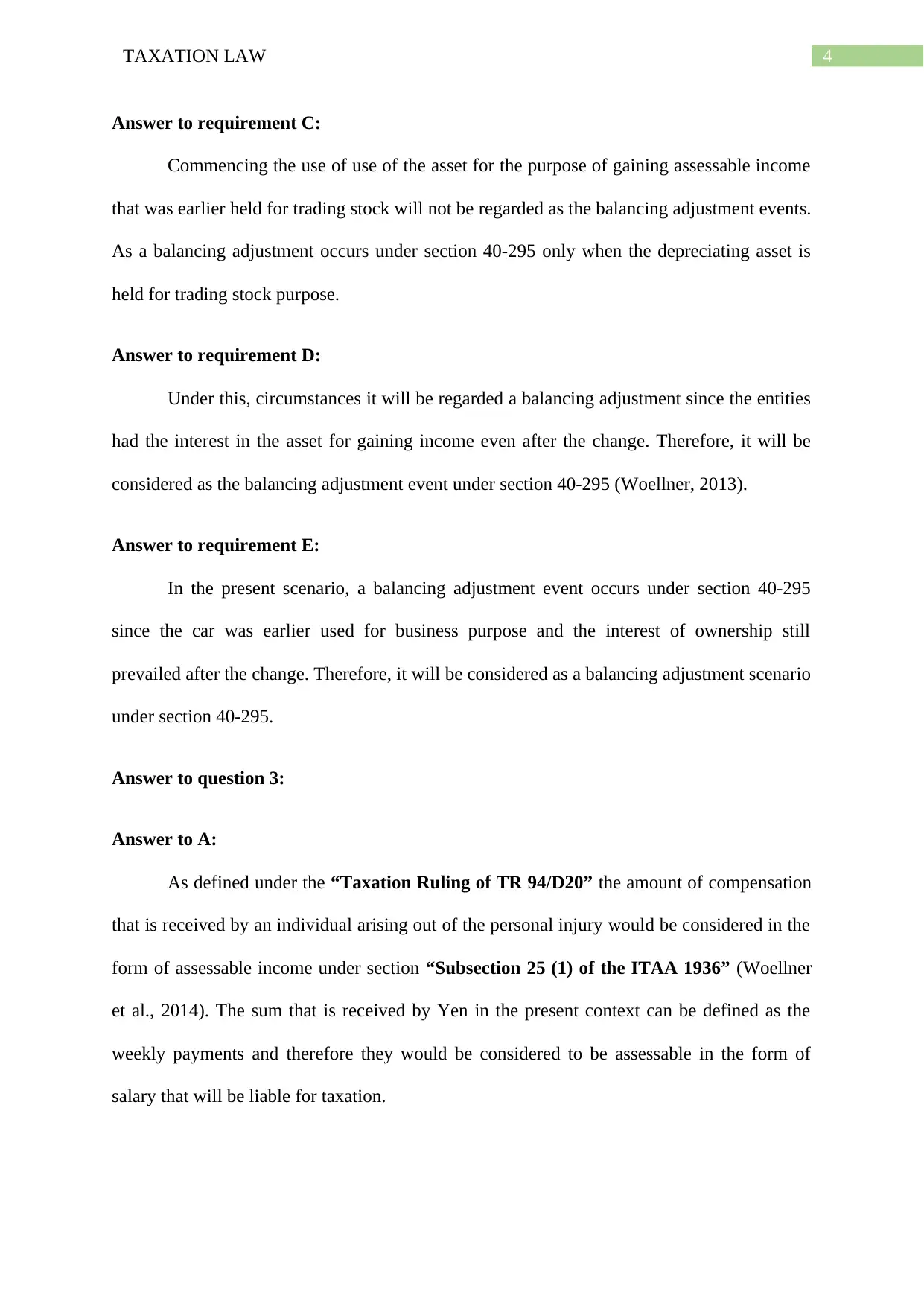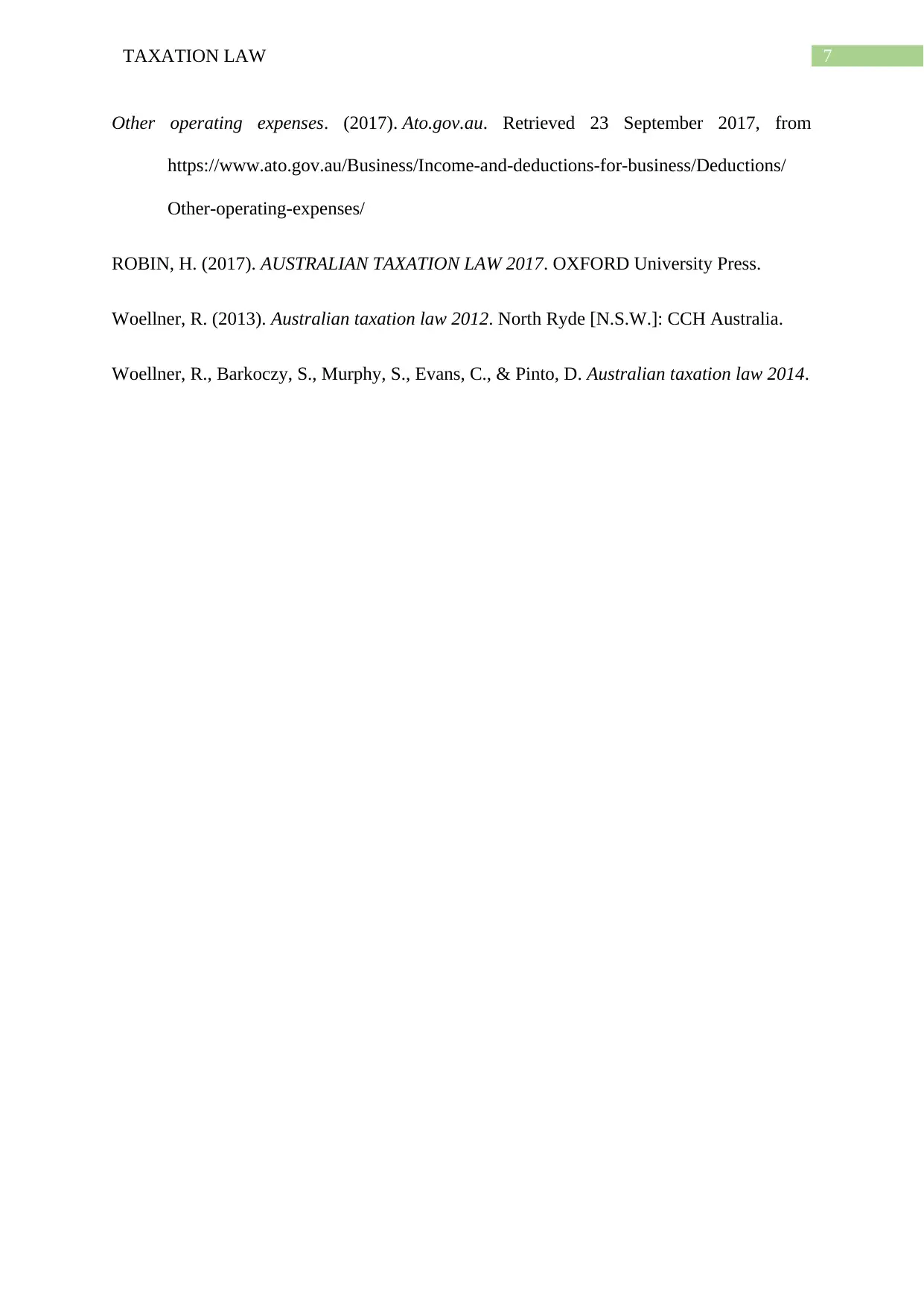Taxation Law Assignment: Analyzing Deductions and Assessable Income
VerifiedAdded on 2020/03/28
|8
|1469
|35
Homework Assignment
AI Summary
This taxation law assignment addresses key aspects of Australian income tax law, providing detailed answers to questions concerning allowable deductions, balancing adjustments for depreciating assets, and the tax treatment of various forms of compensation. The assignment examines specific scenarios, such as accrued wages, advertising expenses, depreciation, interest, and lease payments, to determine whether these expenses qualify as deductible under section 8-1 of the ITAA 1997. Furthermore, it explores situations that trigger balancing adjustments, including changes in asset usage and ownership. Finally, the assignment delves into the tax implications of personal injury compensation, including weekly payments and lump-sum payments for loss of a finger, as well as benefits like ambulance costs and social security disability support pensions, referencing relevant tax rulings and legislation such as the ITAA 1936. The solution includes a comprehensive reference list of sources used.

Running head: TAXATION LAW
Taxation Law
Name of the Student
Name of the University
Authors Note
Course ID
Taxation Law
Name of the Student
Name of the University
Authors Note
Course ID
Paraphrase This Document
Need a fresh take? Get an instant paraphrase of this document with our AI Paraphraser

1TAXATION LAW
Table of Contents
Answer to question 1:.................................................................................................................2
Answer to question 2:.................................................................................................................3
Answer to requirement A:..........................................................................................................3
Answer to requirement B:..........................................................................................................3
Answer to requirement C:..........................................................................................................3
Answer to requirement D:..........................................................................................................4
Answer to requirement E:..........................................................................................................4
Answer to question 3:.................................................................................................................4
Answer to A:..............................................................................................................................4
Answer to B:..............................................................................................................................4
Answer to C:..............................................................................................................................5
Answer to D:..............................................................................................................................5
Reference list:.............................................................................................................................6
Table of Contents
Answer to question 1:.................................................................................................................2
Answer to question 2:.................................................................................................................3
Answer to requirement A:..........................................................................................................3
Answer to requirement B:..........................................................................................................3
Answer to requirement C:..........................................................................................................3
Answer to requirement D:..........................................................................................................4
Answer to requirement E:..........................................................................................................4
Answer to question 3:.................................................................................................................4
Answer to A:..............................................................................................................................4
Answer to B:..............................................................................................................................4
Answer to C:..............................................................................................................................5
Answer to D:..............................................................................................................................5
Reference list:.............................................................................................................................6

2TAXATION LAW
Answer to question 1:
a. Accrued Wages: Accrued wages can be considered as the expense that is “incurred”
either daily or periodically. Accrued wages is regarded as the outgoing that is can be
considered for allowable deductions under section 8-1 of the ITAA 1997 (Robin,
2017).
b. Advertisement: Advertisement expenses can be considered as the allowable
deductions for business since it “incurred” in the form of outgoing that satisfies the
positive limb of section 8-1 of the ITAA 1997.
c. Depreciation: A deductions for depreciation is allowable since it is “incurred” under
section 8-1 of the ITAA 1997 up to the extent the asset is used for work related
purposes (James, 2016).
d. Interest: Interest that is paid on loan can be considered as deductible expense in the
form of outgoing under section 8-1 of the ITAA 1997 only when the expense is
incurred for the purpose of work related purpose.
e. Insurance on plant and equipment: A deductions on insurance “incurred” on
plants and equipment can be allowed for deductions under section 8-1 of the ITAA
1997 since it under the positive parts of section 8-1 of the ITAA 1997 (Coleman &
Sadiq, 2013).
f. Lease Payments: Lease expense can be regarded as the operating expense, which is
incurred by the company in everyday business activities. Therefore, lease payment is
an expense and can it can be considered as allowable deductions under section 8-1 of
the ITAA 1997 (Kenny, 2013).
g. Provision for long service leave: The taxpayer is entitled to claim a deductions for
long service leave provided to the employer under section 8-1 of the ITAA 1997. The
provision for long service leave can be regarded as the expense that is incurred under
Answer to question 1:
a. Accrued Wages: Accrued wages can be considered as the expense that is “incurred”
either daily or periodically. Accrued wages is regarded as the outgoing that is can be
considered for allowable deductions under section 8-1 of the ITAA 1997 (Robin,
2017).
b. Advertisement: Advertisement expenses can be considered as the allowable
deductions for business since it “incurred” in the form of outgoing that satisfies the
positive limb of section 8-1 of the ITAA 1997.
c. Depreciation: A deductions for depreciation is allowable since it is “incurred” under
section 8-1 of the ITAA 1997 up to the extent the asset is used for work related
purposes (James, 2016).
d. Interest: Interest that is paid on loan can be considered as deductible expense in the
form of outgoing under section 8-1 of the ITAA 1997 only when the expense is
incurred for the purpose of work related purpose.
e. Insurance on plant and equipment: A deductions on insurance “incurred” on
plants and equipment can be allowed for deductions under section 8-1 of the ITAA
1997 since it under the positive parts of section 8-1 of the ITAA 1997 (Coleman &
Sadiq, 2013).
f. Lease Payments: Lease expense can be regarded as the operating expense, which is
incurred by the company in everyday business activities. Therefore, lease payment is
an expense and can it can be considered as allowable deductions under section 8-1 of
the ITAA 1997 (Kenny, 2013).
g. Provision for long service leave: The taxpayer is entitled to claim a deductions for
long service leave provided to the employer under section 8-1 of the ITAA 1997. The
provision for long service leave can be regarded as the expense that is incurred under
⊘ This is a preview!⊘
Do you want full access?
Subscribe today to unlock all pages.

Trusted by 1+ million students worldwide

3TAXATION LAW
section 8-1 of the ITAA 1997 for gaining or producing assessable income related to
business (Krever, 2013).
h. Repairs: A deductions is allowable under section 8-1 of the ITAA 1997 relating to
the cost that is incurred by the taxpayer in relation to the repairs for any tools or
equipment up to the extent the tools and equipment are held for gaining or producing
income. The expenses satisfies under positive part of section 8-1 of the ITAA 1997
(Ato.gov.au., 2017).
i. Staff training: A deductions is allowable under section 8-1 of the ITAA 1997
relating to the expense that is incurred on staff training given the fact the training
courses are related to the income generating capacities of the employee and satisfies
the positive part of the section 8-1 (Ato.gov.au., 2017).
j. Taxation expense: A deductions is allowable for taxation expense under section 8-1
of the ITAA 1997 since it considered to be a business expense that is incurred under
the positive limbs of section 8-1 of the ITAA 1997.
Answer to question 2:
Answer to requirement A:
Cannot be considered as the balancing adjustment events under section 40-295.
Answer to requirement B:
It will not be considered as the balancing adjustment events section 40-295 though
there is a change in the ownership of the asset from entirely business purpose to completely
private purpose but it is not used for gaining or producing any assessable income (Morgan et
al., 2013).
section 8-1 of the ITAA 1997 for gaining or producing assessable income related to
business (Krever, 2013).
h. Repairs: A deductions is allowable under section 8-1 of the ITAA 1997 relating to
the cost that is incurred by the taxpayer in relation to the repairs for any tools or
equipment up to the extent the tools and equipment are held for gaining or producing
income. The expenses satisfies under positive part of section 8-1 of the ITAA 1997
(Ato.gov.au., 2017).
i. Staff training: A deductions is allowable under section 8-1 of the ITAA 1997
relating to the expense that is incurred on staff training given the fact the training
courses are related to the income generating capacities of the employee and satisfies
the positive part of the section 8-1 (Ato.gov.au., 2017).
j. Taxation expense: A deductions is allowable for taxation expense under section 8-1
of the ITAA 1997 since it considered to be a business expense that is incurred under
the positive limbs of section 8-1 of the ITAA 1997.
Answer to question 2:
Answer to requirement A:
Cannot be considered as the balancing adjustment events under section 40-295.
Answer to requirement B:
It will not be considered as the balancing adjustment events section 40-295 though
there is a change in the ownership of the asset from entirely business purpose to completely
private purpose but it is not used for gaining or producing any assessable income (Morgan et
al., 2013).
Paraphrase This Document
Need a fresh take? Get an instant paraphrase of this document with our AI Paraphraser

4TAXATION LAW
Answer to requirement C:
Commencing the use of use of the asset for the purpose of gaining assessable income
that was earlier held for trading stock will not be regarded as the balancing adjustment events.
As a balancing adjustment occurs under section 40-295 only when the depreciating asset is
held for trading stock purpose.
Answer to requirement D:
Under this, circumstances it will be regarded a balancing adjustment since the entities
had the interest in the asset for gaining income even after the change. Therefore, it will be
considered as the balancing adjustment event under section 40-295 (Woellner, 2013).
Answer to requirement E:
In the present scenario, a balancing adjustment event occurs under section 40-295
since the car was earlier used for business purpose and the interest of ownership still
prevailed after the change. Therefore, it will be considered as a balancing adjustment scenario
under section 40-295.
Answer to question 3:
Answer to A:
As defined under the “Taxation Ruling of TR 94/D20” the amount of compensation
that is received by an individual arising out of the personal injury would be considered in the
form of assessable income under section “Subsection 25 (1) of the ITAA 1936” (Woellner
et al., 2014). The sum that is received by Yen in the present context can be defined as the
weekly payments and therefore they would be considered to be assessable in the form of
salary that will be liable for taxation.
Answer to requirement C:
Commencing the use of use of the asset for the purpose of gaining assessable income
that was earlier held for trading stock will not be regarded as the balancing adjustment events.
As a balancing adjustment occurs under section 40-295 only when the depreciating asset is
held for trading stock purpose.
Answer to requirement D:
Under this, circumstances it will be regarded a balancing adjustment since the entities
had the interest in the asset for gaining income even after the change. Therefore, it will be
considered as the balancing adjustment event under section 40-295 (Woellner, 2013).
Answer to requirement E:
In the present scenario, a balancing adjustment event occurs under section 40-295
since the car was earlier used for business purpose and the interest of ownership still
prevailed after the change. Therefore, it will be considered as a balancing adjustment scenario
under section 40-295.
Answer to question 3:
Answer to A:
As defined under the “Taxation Ruling of TR 94/D20” the amount of compensation
that is received by an individual arising out of the personal injury would be considered in the
form of assessable income under section “Subsection 25 (1) of the ITAA 1936” (Woellner
et al., 2014). The sum that is received by Yen in the present context can be defined as the
weekly payments and therefore they would be considered to be assessable in the form of
salary that will be liable for taxation.

5TAXATION LAW
Answer to B:
In the present context, it is evident that Yen received a compensation for the loss of
finger. Amount of compensation in the form of lump sum received by an individual due to
the loss of the finger is related to the payment made for personal injury. In accordance with
“Subsection 25 (1) of the ITAA 1936” receipt of sum related to the personal injury are
usually considered to be a tax-free element (Krever, 2013). It is noteworthy to denote that
receipt of lump sum payment that is made relating to the physical injury is treated under the
common law as a payment that is not regarded as taxable component.
Answer to C:
Amount of ambulance cost that is paid to Yan by the employer is regarded as the
benefit therefore such amount wold be included in the assessable income of Yan.
Answer to D:
Social security disability support pension should be viewed as the benefit having the
character of income in nature. Such income are regarded as the taxable component entirely
for the year in which such income is received by the taxpayer. Therefore, the disability
support payment are treated as income and would be considered for taxation purpose under
“Section 25 (1) of the ITAA” (Coleman & Sadiq, 2013). Sum received by Yen in the form
of social security disability support pension would be treated as the insured individual lost
income on the event of injury. Hence, such amount would be included in the taxable income
and shall be held for taxation under “Subsection 25 (1)”.
Answer to B:
In the present context, it is evident that Yen received a compensation for the loss of
finger. Amount of compensation in the form of lump sum received by an individual due to
the loss of the finger is related to the payment made for personal injury. In accordance with
“Subsection 25 (1) of the ITAA 1936” receipt of sum related to the personal injury are
usually considered to be a tax-free element (Krever, 2013). It is noteworthy to denote that
receipt of lump sum payment that is made relating to the physical injury is treated under the
common law as a payment that is not regarded as taxable component.
Answer to C:
Amount of ambulance cost that is paid to Yan by the employer is regarded as the
benefit therefore such amount wold be included in the assessable income of Yan.
Answer to D:
Social security disability support pension should be viewed as the benefit having the
character of income in nature. Such income are regarded as the taxable component entirely
for the year in which such income is received by the taxpayer. Therefore, the disability
support payment are treated as income and would be considered for taxation purpose under
“Section 25 (1) of the ITAA” (Coleman & Sadiq, 2013). Sum received by Yen in the form
of social security disability support pension would be treated as the insured individual lost
income on the event of injury. Hence, such amount would be included in the taxable income
and shall be held for taxation under “Subsection 25 (1)”.
⊘ This is a preview!⊘
Do you want full access?
Subscribe today to unlock all pages.

Trusted by 1+ million students worldwide

6TAXATION LAW
Reference list:
Coleman, C., & Sadiq, K. Principles of taxation law 2013.
James, K. (2016). The Australian Taxation Office perspective on work-related travel expense
deductions for academics. International Journal of Critical Accounting, 8(5-6), 345-
362.
Kenny, P. (2013). Australian tax 2013. Chatswood, N.S.W.: LexisNexis Butterworths.
Krever, R. (2013). Australian taxation law cases 2013. Pyrmont, N.S.W.: Thomson Reuters.
Legal Database. (2017). Ato.gov.au. Retrieved 23 September 2017, from
https://www.ato.gov.au/law/view/document?DocID=TXR/TR986/NAT/ATO/00001
Morgan, A., Mortimer, C., & Pinto, D. (2013). A practical introduction to Australian
taxation law. North Ryde [N.S.W.]: CCH Australia.
Reference list:
Coleman, C., & Sadiq, K. Principles of taxation law 2013.
James, K. (2016). The Australian Taxation Office perspective on work-related travel expense
deductions for academics. International Journal of Critical Accounting, 8(5-6), 345-
362.
Kenny, P. (2013). Australian tax 2013. Chatswood, N.S.W.: LexisNexis Butterworths.
Krever, R. (2013). Australian taxation law cases 2013. Pyrmont, N.S.W.: Thomson Reuters.
Legal Database. (2017). Ato.gov.au. Retrieved 23 September 2017, from
https://www.ato.gov.au/law/view/document?DocID=TXR/TR986/NAT/ATO/00001
Morgan, A., Mortimer, C., & Pinto, D. (2013). A practical introduction to Australian
taxation law. North Ryde [N.S.W.]: CCH Australia.
Paraphrase This Document
Need a fresh take? Get an instant paraphrase of this document with our AI Paraphraser

7TAXATION LAW
Other operating expenses. (2017). Ato.gov.au. Retrieved 23 September 2017, from
https://www.ato.gov.au/Business/Income-and-deductions-for-business/Deductions/
Other-operating-expenses/
ROBIN, H. (2017). AUSTRALIAN TAXATION LAW 2017. OXFORD University Press.
Woellner, R. (2013). Australian taxation law 2012. North Ryde [N.S.W.]: CCH Australia.
Woellner, R., Barkoczy, S., Murphy, S., Evans, C., & Pinto, D. Australian taxation law 2014.
Other operating expenses. (2017). Ato.gov.au. Retrieved 23 September 2017, from
https://www.ato.gov.au/Business/Income-and-deductions-for-business/Deductions/
Other-operating-expenses/
ROBIN, H. (2017). AUSTRALIAN TAXATION LAW 2017. OXFORD University Press.
Woellner, R. (2013). Australian taxation law 2012. North Ryde [N.S.W.]: CCH Australia.
Woellner, R., Barkoczy, S., Murphy, S., Evans, C., & Pinto, D. Australian taxation law 2014.
1 out of 8
Related Documents
Your All-in-One AI-Powered Toolkit for Academic Success.
+13062052269
info@desklib.com
Available 24*7 on WhatsApp / Email
![[object Object]](/_next/static/media/star-bottom.7253800d.svg)
Unlock your academic potential
Copyright © 2020–2025 A2Z Services. All Rights Reserved. Developed and managed by ZUCOL.





